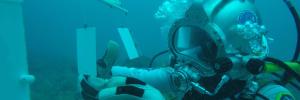
Matie teams up with NASA for extreme underwater mission
Five, four, three, two, one… Stellenbosch University alumnus, Dr Noel du Toit, is taking the plunge and braving the deep sea on 26 July to live and do research at the bottom of the Atlantic Ocean for eight days as part of a NASA mission.
The mission, known as NASA Extreme Environment Mission Operations project 21 (NEEMO 21), involves studying human/robotic interaction and preparing for future deep space missions. NEEMO missions typically involve sending three to four astronauts from NASA, the European Space Agency (ESA) and the Japanese Space Agency (JAXA) and other subject matter experts to live underwater for up to three weeks.
During these missions, the astronauts (known as aquanauts) focus on evaluating tools and techniques being tested for future space exploration. The aquanauts live in simulated spacecraft conditions and conduct simulated spacewalks outside of their undersea habitat (as though they are on the International Space Station). The mission takes place at the Aquarius habitat (https://aquarius.fiu.edu/), an undersea research station off the coast of Key Largo in Florida - the last facility of its kind in the world.
"I will be performing science tasks ranging from DNA sequencing to coral sampling, as well as human-robot interaction tasks. My stay will include five 'spacewalks' and a multitude of habitat-based science tasks and human physiology studies. This unique opportunity will result in me becoming one of less than 800 people around the world that have lived underwater like this," explains Du Toit, who currently works as a Research Assistant Professor in Mechanical Engineering at the Naval Postgraduate School in Monterey, California.
Du Toit's focus is on the development and deployment of maritime robotic systems and Autonomous Underwater Vehicles (AUVs). "I have always been particularly interested in the ocean, and maritime robotics are the perfect way for me to utilise my technical training to contribute to society in a direct and meaningful way by providing increasingly capable technologies and tools to explore our oceans," he says.
He grew up outside of Pretoria on a rose farm, completed his degree in Mechanical Engineering at Maties and went to the United States in 2003 for graduate school. He obtained a Masters' degree from MIT in 2005 and a PhD from the California Institute of Technology in 2010. "My academic focus was on control theory and robotics, and I have worked on unmanned ground vehicles (self-driving cars), aerial vehicles (quad rotors and fixed-wing UAVs), surface vehicles and underwater vehicles," he says.
According to Du Toit, Stellenbosch University's world-class education gave him the ideal launch pad for his pursuit of engineering research. "There are many opportunities for graduate work in the States and beyond, and though that may not be an appropriate path for everyone, my sense is that the students in South Africa do not pursue those opportunities because they are unaware or simply do not believe it possible. My advice is: pursue your dreams because you will never know if you do not try."
- You can follow this mission live on https://aquarius.fiu.edu/media/watch-live/. For social media updates on Twitter, follow @aqua_dutoit; @NASA_NEEMO and on Facebook you can go to https://www.facebook.com/NASA… and https://www.facebook.com/AquariusReefBase/
- Photos courtesy: Noel du Toit & NASA
